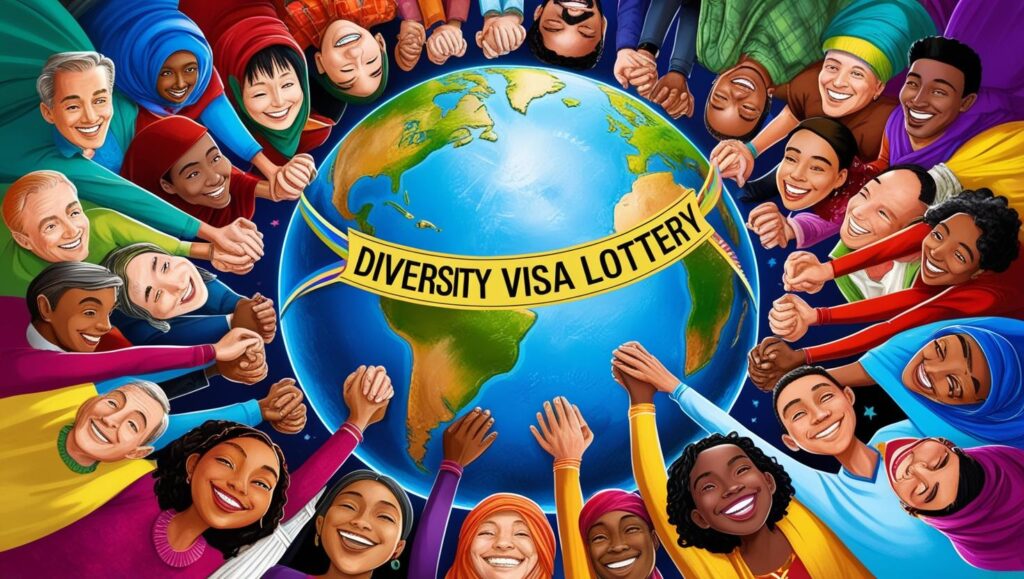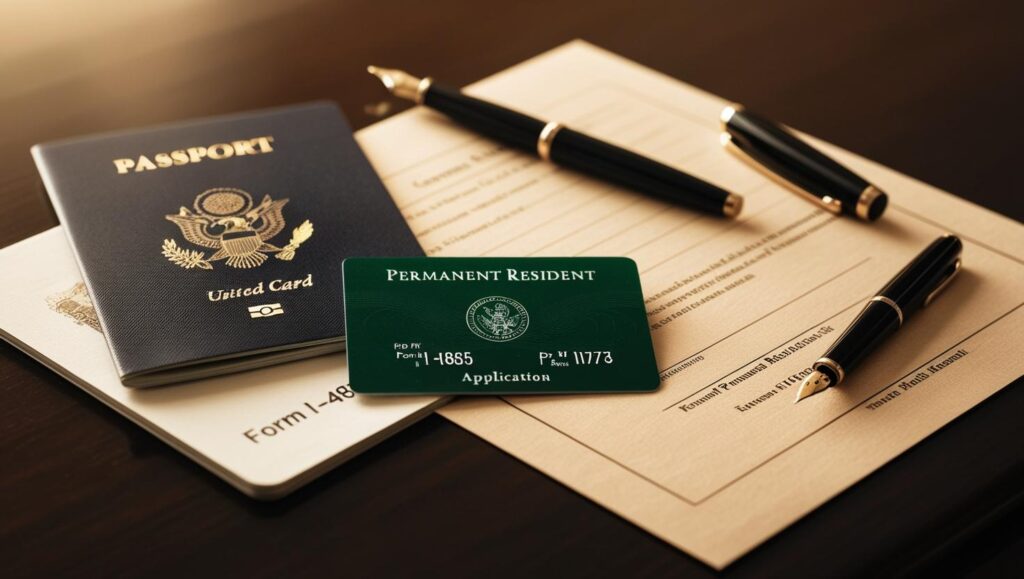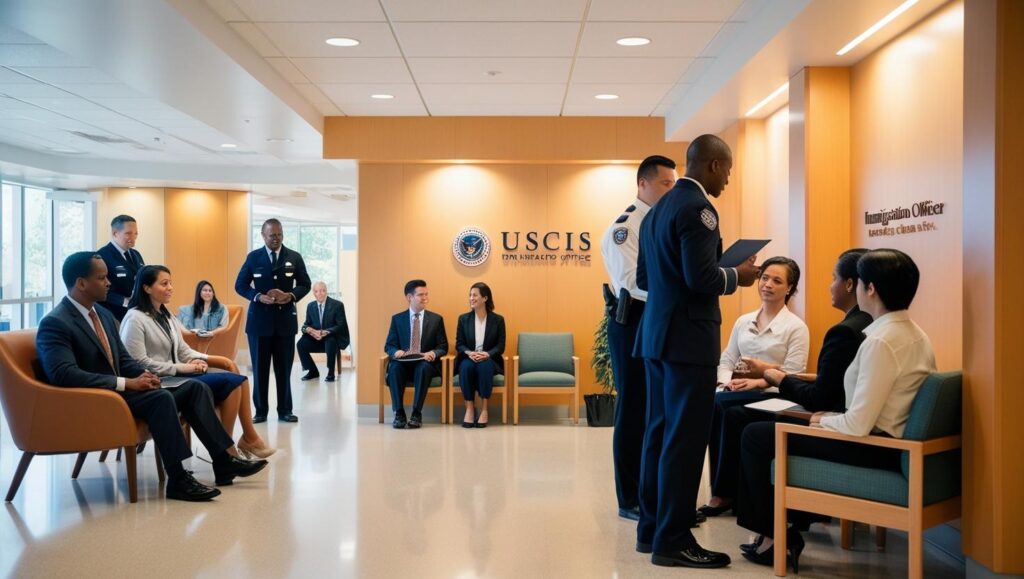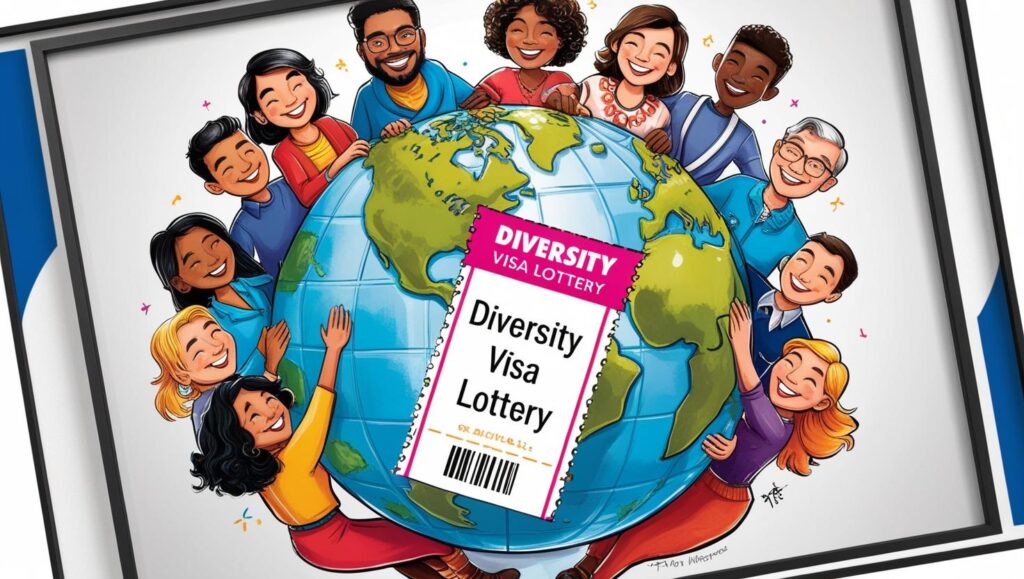Navigating the U.S. immigration system can feel overwhelming, especially when it comes to understanding the green card process. Officially known as a Permanent Resident Card, a green card allows individuals to live and work permanently in the United States. Whether you’re applying for the first time, renewing your current green card, or exploring options for family members, this guide will break down the eligibility requirements and the USCIS application process in a way that’s easy to follow.
What Is a Green Card and Why Is It Important?
A green card, also known as an Alien Registration Card, is proof of lawful permanent resident status in the U.S. It’s more than just a document—it’s your ticket to live and work permanently in the United States. Green card holders, or lawful permanent residents, enjoy many benefits, such as the ability to apply for U.S. citizenship after a certain period, sponsor eligible family members for their own green cards, and travel outside the U.S. with fewer restrictions compared to other visa holders.
However, obtaining a green card is not a one-size-fits-all process. The eligibility requirements and application process vary depending on your specific situation, such as whether you’re applying through family, employment, or other special categories.
Green Card Eligibility Requirements: Who Can Apply?
To apply for a green card, you must meet specific eligibility requirements based on your category. The U.S. Citizenship and Immigration Services (USCIS) outlines several pathways to permanent residency, including family-based, employment-based, and humanitarian options. Let’s explore the most common eligibility categories:
1. Family-Based Green Cards
- If you are an immediate relative of a U.S. citizen (spouse, unmarried child under 21, or parent), you may be eligible to apply for a green card.
- Other family members, such as siblings of U.S. citizens or spouses and children of lawful permanent residents, may also apply, but their applications are subject to visa availability.
- To start the process, a U.S. citizen or lawful permanent resident must file Form I-130, Petition for Alien Relative, on your behalf.
2. Employment-Based Green Cards
- Employment-based green cards are available to individuals with specific job offers, extraordinary abilities, or specialized skills.
- Categories include EB-1 (priority workers), EB-2 (advanced degree professionals), and EB-3 (skilled workers).
- Employers typically file Form I-140, Immigrant Petition for Alien Worker, to sponsor the applicant.
3. Diversity Visa Lottery
- The Diversity Visa Lottery, also known as the Green Card Lottery, is a program that randomly selects applicants from countries with historically low immigration rates to the U.S.
- If selected, you can apply for an immigrant visa and proceed to the next steps of the green card process.

4. Humanitarian Programs
- Refugees, asylees, and victims of human trafficking or abuse may also be eligible for a green card under humanitarian programs.
- These categories often require additional documentation to prove your status and eligibility.
5. Other Special Categories
- Certain individuals, such as those who have lived in the U.S. continuously for a long period or are eligible under specific laws, may also qualify for permanent residency.
The USCIS Green Card Application Process
Once you determine your eligibility category, the next step is to navigate the green card application process. While the steps may vary depending on your situation, here’s a general overview of what to expect:
Step 1: File the Appropriate Petition
- Most green card applications begin with a petition filed by a sponsor, such as a family member or employer. For example:
- Family-based applicants: File Form I-130.
- Employment-based applicants: File Form I-140.
- In some cases, you may be able to self-petition, such as if you qualify as an individual with extraordinary ability.
Step 2: Wait for USCIS Approval
- Once the petition is filed, USCIS will review it to determine if you meet the eligibility requirements. If the petition is approved, you can proceed to the next step.
Step 3: Check Visa Availability
- For most categories, a visa must be available before you can apply for a green card. The Department of State’s Visa Bulletin provides monthly updates on visa availability based on your category and country of origin.
Step 4: File Form I-485 or Apply for an Immigrant Visa
- If you are already in the U.S., you can file Form I-485, Application to Register Permanent Residence or Adjust Status, to apply for a green card. This process is known as adjustment of status.
- If you are outside the U.S., you will need to apply for an immigrant visa through consular processing at a U.S. embassy or consulate.
Step 5: Attend Biometrics and Interviews
- USCIS may require you to attend a biometrics appointment to collect your fingerprints, photo, and signature.
- In most cases, you will also need to attend an interview to verify your eligibility and provide additional documentation.
Step 6: Receive Your Green Card
- If your application is approved, you will receive your green card in the mail. Congratulations—you are now a lawful permanent resident of the United States!

Common Questions About the Green Card Process
How Long Does the Green Card Process Take?
The processing time for a green card application depends on your eligibility category, visa availability, and USCIS workload. Some applications, such as those for immediate relatives of U.S. citizens, may be processed faster than others. It’s important to check the USCIS Policy Manual and processing time estimates for the most accurate information.
Can I Renew My Green Card?
Yes, green cards must be renewed every ten years. If your green card is about to expire, you can file Form I-90, Application to Replace Permanent Resident Card, to renew it. It’s important to start the renewal process early to avoid any gaps in your lawful permanent resident status.
What Happens If My Green Card Application Is Denied?
If your application is denied, USCIS will provide a detailed explanation of the reasons for the denial. In some cases, you may be able to appeal the decision or reapply with additional documentation.
Tips for a Smooth Green Card Application Process
- Use Secure Websites: Always ensure you are using official government websites, such as USCIS.gov, to file forms and check your application status.
- Double-Check Your Forms: Small errors on your application forms can lead to delays or denials. Take the time to review everything carefully.
- Stay Informed: Immigration policies and procedures can change frequently. Stay updated by checking the USCIS Policy Manual and other official resources.
- Seek Professional Help: If you’re unsure about any part of the process, consider consulting an immigration attorney or accredited representative.

Understanding the Diversity Visa Lottery
The Diversity Visa Lottery, often referred to as the Green Card Lottery, is a unique program designed to promote diversity in U.S. immigration. Each year, the U.S. Department of State randomly selects up to 55,000 applicants from countries with historically low immigration rates to the United States. If you’re lucky enough to be selected, you can apply for an immigrant visa and eventually receive a green card.
Who Is Eligible for the Diversity Visa Lottery?
To qualify for the Diversity Visa Lottery, you must meet two key requirements:
- Country of Birth: You must be born in an eligible country. The list of eligible countries changes annually, so it’s important to check the official Diversity Visa Lottery website for updates.
- Education or Work Experience: You must have at least a high school diploma or two years of work experience in a qualifying occupation within the last five years.
How to Apply for the Diversity Visa Lottery
- Submit Your Entry Online: Applications for the Diversity Visa Lottery are submitted online through the official U.S. government website. Be cautious of fraudulent websites that claim to guarantee selection.
- Keep Your Confirmation Number: After submitting your application, you’ll receive a confirmation number. This number is essential for checking your application status.
- Wait for the Results: If you’re selected, you’ll be notified and given instructions on how to proceed with your immigrant visa application.
What Happens After Selection?
If you’re selected in the Diversity Visa Lottery, you’ll need to complete the immigrant visa application process, which includes submitting Form DS-260, attending an interview, and providing supporting documents. Once your application is approved, you can enter the U.S. as a lawful permanent resident and receive your green card.

Adjustment of Status vs. Consular Processing
When applying for a green card, you’ll need to decide whether to adjust your status or go through consular processing. The choice depends on whether you’re currently in the U.S. or outside the country.
Adjustment of Status
Adjustment of status is the process of applying for a green card while you’re already in the U.S. This option is available to individuals who entered the country legally and meet the eligibility requirements for their green card category.
- File Form I-485: To begin the adjustment of status process, you’ll need to file Form I-485, Application to Register Permanent Residence or Adjust Status.
- Work and Travel Authorization: While your application is pending, you can apply for employment authorization (Form I-765) and advance parole (Form I-131) to work and travel legally.
- Attend an Interview: Most applicants will be required to attend an interview with a USCIS officer to verify their eligibility.
Consular Processing
If you’re outside the U.S., you’ll need to apply for an immigrant visa through consular processing. This involves submitting your application to a U.S. embassy or consulate in your home country.
- Submit Form DS-260: The immigrant visa application is completed online using Form DS-260.
- Attend a Medical Exam and Interview: You’ll need to undergo a medical examination and attend an interview at the U.S. embassy or consulate.
- Enter the U.S.: Once your visa is approved, you can travel to the U.S. and receive your green card upon arrival.
Avoiding Common Mistakes in the Green Card Process
The green card application process can be complex, and even small mistakes can lead to delays or denials. Here are some common pitfalls to avoid:
1. Submitting Incomplete or Incorrect Forms
One of the most common reasons for delays is submitting forms with missing or incorrect information. Double-check all forms, including Form I-485, Form I-130, and Form I-140, to ensure they are complete and accurate.
2. Missing Deadlines
Immigration deadlines are strict, and missing one can jeopardize your application. Keep track of important dates, such as filing deadlines, interview appointments, and visa availability updates.
3. Failing to Provide Supporting Documents
USCIS and the Department of State require extensive documentation to verify your eligibility. Make sure to include all required documents, such as birth certificates, marriage certificates, and proof of financial support (e.g., Form I-864, Affidavit of Support).
4. Not Checking Visa Availability
For most green card categories, a visa must be available before you can proceed with your application. Use the Visa Bulletin to check the availability of visas in your category and country of origin.
5. Falling for Scams
Unfortunately, immigration scams are common. Be wary of anyone who guarantees a green card or charges excessive fees for services. Always use official government websites, such as USCIS.gov, to file forms and check your application status.

What Happens After You Receive Your Green Card?
Once you receive your green card, you officially become a lawful permanent resident of the United States. Here’s what you need to know about maintaining your status:
1. Renewing Your Green Card
Green cards are typically valid for 10 years. If your card is about to expire, you’ll need to file Form I-90, Application to Replace Permanent Resident Card, to renew it. It’s important to start the renewal process at least six months before your card expires.
2. Traveling Outside the U.S.
As a green card holder, you can travel outside the U.S., but there are some restrictions. If you plan to stay outside the U.S. for an extended period (usually more than six months), you may need to apply for a reentry permit to maintain your permanent resident status.
3. Applying for U.S. Citizenship
After holding a green card for a certain period (usually five years, or three years if married to a U.S. citizen), you may be eligible to apply for U.S. citizenship. Becoming a U.S. citizen offers additional benefits, such as the right to vote and protection from deportation.
Final Thoughts on the Green Card Process
The journey to obtaining a green card can be challenging, but it’s also a life-changing opportunity to live and work permanently in the United States. By understanding the eligibility requirements, following the USCIS application process, and avoiding common mistakes, you can increase your chances of success.
Whether you’re applying through family, employment, or the Diversity Visa Lottery, staying informed and organized is key. If you’re ever unsure about a step in the process, don’t hesitate to seek professional guidance from an immigration attorney or accredited representative. With patience and preparation, you’ll be well on your way to achieving permanent residency in the U.S.
FAQs
What is a Green Card and why is it important for immigration?
A Green Card, also known as a Permanent Resident Card, is an official document that proves your status as a lawful permanent resident in the United States. It’s crucial for immigration as it allows you to live and work in the U.S. permanently, and is a step towards obtaining US citizenship.
How can I apply for a Green Card?
To apply for a Green Card, you need to determine your eligibility category and then follow the USCIS application process. This typically involves filing Form I-485 (Application to Register Permanent Residence or Adjust Status) if you’re in the U.S., or applying for an immigrant visa through a U.S. embassy or consulate if you’re outside the US. If you choose to go the EB1A or EB2-NIW route, Green Card For Alien can help with the writing of the main petition and the reference letters.
What are the main eligibility categories to get a Green Card?
The main eligibility categories include family-based immigration, employment-based immigration, refugee or asylee status, and the Diversity Immigrant Visa Program (also known as the Green Card lottery). Each category has specific requirements that Green Card applicants must meet.
How long does the Green Card application process take?
The processing time varies depending on your eligibility category and current USCIS workload. It can take anywhere from several months to several years. You can check the status of your application on the USCIS gov website once you’ve submitted your forms.

Is there a way to get a Green Card through the lottery system?
Yes, the Diversity Immigrant Visa Program, commonly known as the Green Card lottery, provides a chance for people from countries with low rates of immigration to the U.S. to obtain a Green Card. The program is run annually, and winners are selected randomly.
How long can I stay outside the US as a Green Card holder?
As a lawful permanent resident, you should not stay outside the US for more than one year without obtaining a re-entry permit. Extended absences may jeopardize your permanent resident status. If you plan to be away for more than a year, consult with an immigration attorney.
How often do I need to renew my Green Card?
You need to renew your Green Card every ten years. It’s recommended to start the renewal process about six months before your current card expires. You can do this by filing Form I-90 with USCIS.
Can my family members also apply for a Green Card if I get one?
In many cases, yes. If you become a lawful permanent resident, your immediate family members (spouse and unmarried children under 21) may be eligible to apply for Green Cards as well. The process and waiting times can vary depending on your specific situation.
How long do I need to wait before I can apply for US citizenship after getting a Green Card?
Generally, you need to have been a lawful permanent resident for at least five years before you can apply for US citizenship. However, if you’re married to a US citizen, you may be eligible to apply after three years. There are also other requirements, such as continuous residence and good moral character, that you must meet.

